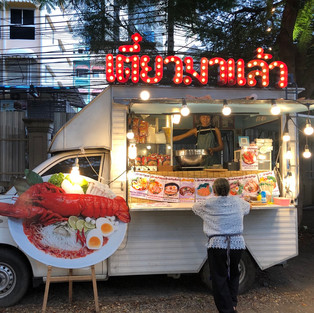Escaping Bangkok
- Caitlin X
- Sep 15, 2019
- 2 min read
I was introduced to Thailand through Bangkok’s tropical heat and traffic-filled streets. I was surrounded by giant malls, fragrant street markets and cigarette smoke filled bars, and my lungs needed a break. While Bangkok was new and exciting, it was still a fast-paced urban center with access to all of the amenities I was used to, so it was time to experience life outside of the city lights and smog.
My uncle hired a taxi to drive him, his friend and family, my cousin, and me around Ayutthaya, a city one hour north of Bangkok. When we arrived at the Ayutthaya Elephant Village and Floating Market, I immediately woke up from my nap; in the place of high-rise buildings was a busy market discernible by its many colorful tents, pens full of goats, and of course, elephants.
Seeing so many of these gentle, grey animals was a little overwhelming. I had never seen one up close before, and was struck with how big and hairy they actually were. I didn’t even know they had hair. I was caught between my awe at their foreignness, and amusement at how nonchalantly the elephant riders stepped on the animals’ heads to climb up while tossing cigarette butts down onto the straw-covered floor.
The umbrella provided shade from the unrelenting sun. We sat on a narrow bench attached to a harness, which swayed to the rhythm of the elephant’s slow pace. The ride lasted half an hour, in which we made a lap around a crumbling temple. There were many detours, where the elephant decided to wander off the path and eat plants or grab branches from low hanging trees.

We rode a skiff through the floating market. The water winded under bridges, past vendors selling street food and trinkets, and performance platforms. Flowers decorated the riverbank, and fish could be seen swarming near the feeding station. Afterwards, we walked the entire market and ate a few different foods.
A UNESCO World Heritage site, Ayutthaya Historical Park was once the capitol. We were able to walk among the crumbling walls through what once was a beautiful complex in the 14th century. It now holds remnants of its former glory in temple ruins and decapitated statues. In 1767, the Burmese cut the heads off of the statues to look for gold after destroying much the area. This place has so much history, that being able to walk among its remains evoked a feeling similar to that of holding an ancient and rare artifact in a museum that you feel you should not be touching. Such a feeling gives you glimpses of events and people long gone, and of a humanity half remembered.

















Comments